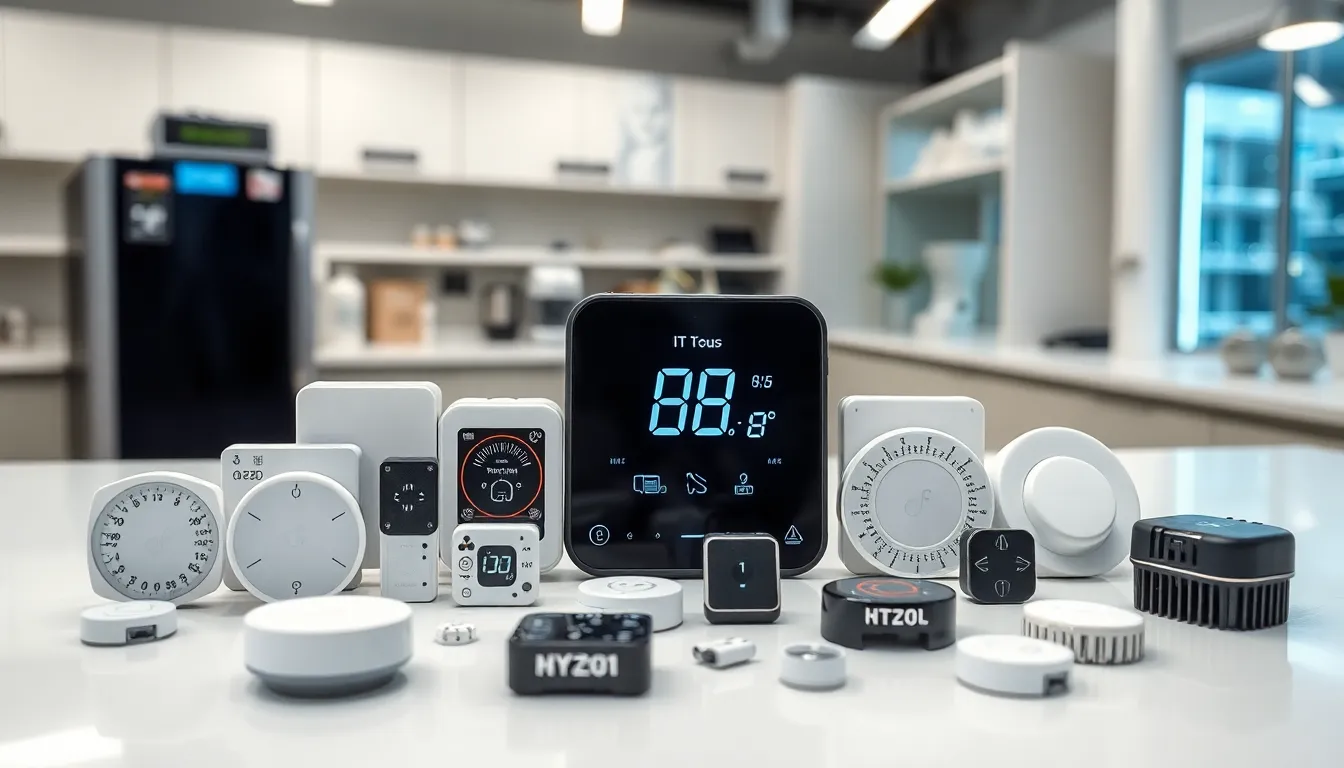In today’s fast-paced digital landscape, the Internet of Things (IoT) and big data are transforming how businesses operate and make decisions. As devices become increasingly interconnected, they generate vast amounts of data that hold the potential to unlock new insights and drive innovation. This synergy between IoT and big data isn’t just a trend; it’s a fundamental shift in how organizations harness information to enhance efficiency and improve customer experiences.
The integration of IoT with big data analytics empowers companies to collect, analyze, and act on real-time information like never before. By leveraging this powerful combination, businesses can optimize operations, predict market trends, and deliver personalized services. As technology continues to evolve, understanding the interplay between IoT and big data becomes essential for staying competitive in an ever-changing marketplace.
Table of Contents
ToggleOverview of IoT and Big Data
The Internet of Things (IoT) encompasses a network of interconnected devices that communicate with each other and share data. These devices range from consumer electronics to industrial machinery, providing a continual stream of information. Big data refers to the large volumes of structured and unstructured data generated by these connected devices. Together, IoT and big data create a powerful engine for analysis and insight.
IoT generates significant data, with projections estimating that by 2025, there will be over 75 billion connected devices globally. This data contains patterns and trends that traditional analytics often miss. Organizations can harness this data to inform decision-making and drive innovation.
Big data analytics aids in processing and analyzing this influx of information. It transforms raw data into actionable insights through advanced algorithms and machine learning techniques. This transformation enables businesses to identify operational inefficiencies, enhance customer experiences, and predict future trends based on past behaviors.
The synergy between IoT and big data not only improves operational efficiency but also fosters new business models. Companies that integrate these technologies can adapt quickly to market changes and customer needs. This adaptability positions organizations favorably in competitive landscapes.
Furthermore, the combination of IoT and big data enhances predictive maintenance. For instance, manufacturers can monitor equipment in real-time to anticipate failures before they occur. As a result, this proactive approach reduces downtime and maintenance costs.
Understanding the relationship between IoT and big data equips businesses with the tools needed to thrive in the digital economy. Embracing this integration leads to informed strategies that drive performance and growth.
Key Components of IoT

Key components of the Internet of Things (IoT) facilitate the interconnectedness of devices and the seamless flow of data. Understanding these components is crucial for leveraging IoT capabilities effectively.
Sensors and Devices
Sensors and devices form the backbone of IoT systems. These components collect data from their environments. For example, temperature sensors monitor climate conditions, while motion sensors detect movement. Other examples include moisture sensors in agriculture and RFID tags in supply chain management. Each sensor plays a vital role in generating real-time data that can be analyzed for insights.
Connectivity Technologies
Connectivity technologies enable devices to communicate with one another and transmit data to centralized systems. Common connectivity options include Wi-Fi, Bluetooth, Zigbee, and cellular networks. Each option provides different advantages regarding range, power consumption, and bandwidth. For instance, Wi-Fi offers high data transfer rates for home devices, while Zigbee supports low-power devices in smart homes. Understanding these technologies helps businesses select the right solutions for their specific IoT applications.
The Role of Big Data in IoT
Big data significantly enhances the functionalities of the Internet of Things (IoT) by enabling efficient data collection, processing, and analysis. This integration transforms raw data into valuable insights that drive innovation and decision-making.
Data Collection and Storage
Data collection in IoT relies on various sensors and devices that gather information from their environments. Temperature sensors, motion detectors, and smart meters exemplify the tools used to collect critical data. These devices generate vast amounts of data, which necessitates robust storage solutions. Companies utilize cloud-based storage systems to accommodate this data influx, facilitating easier access and management. Methods such as data partitioning and compression help ensure efficient storage, allowing for quick retrieval and analysis.
Data Processing and Analysis
Data processing starts once the information is collected and stored. Advanced algorithms and machine learning techniques play a pivotal role in transforming unstructured data into structured formats. This conversion is essential for extracting actionable insights. Streaming analytics tools enable real-time processing, offering immediate analysis of data as it flows in. By employing visualization tools, companies can present findings in an intuitive manner, aiding strategic decisions. Predictive analytics, a key aspect of this phase, enables organizations to forecast trends and optimize their operations based on historical data and patterns.
Benefits of Integrating IoT and Big Data
Integrating IoT and big data delivers significant advantages, particularly in decision-making and predictive analytics. These benefits empower organizations to harness real-time data effectively and refine strategic approaches.
Enhanced Decision Making
Enhanced decision-making stems from the ability to analyze vast amounts of real-time data from IoT devices. Organizations can gain insights into operations, customer behavior, and market trends. Data visualization tools simplify complex datasets, making it easier for stakeholders to interpret information quickly. Actionable insights derived from data analytics support informed business strategies, improving responsiveness to market dynamics.
Predictive Analytics
Predictive analytics transforms historical data into forward-looking insights. By analyzing patterns from past events, businesses can anticipate future trends, customer preferences, and operational challenges. IoT devices continuously collect data, feeding analytical models that enhance accuracy. Companies leverage predictive maintenance to minimize equipment failure and optimize resource allocation. This proactive approach reduces costs while maximizing efficiency, ensuring that organizations remain competitive in an evolving landscape.
Challenges in IoT and Big Data Implementation
Implementing IoT and big data involves various challenges that organizations must navigate to fully utilize these technologies. Addressing these issues is crucial for achieving optimal results.
Security and Privacy Concerns
Security and privacy remain primary challenges in IoT and big data integration. Connected devices often transmit sensitive information, increasing the risk of data breaches and unauthorized access. According to a report by Cybersecurity Ventures, cybercrime costs could reach $10.5 trillion annually by 2025. Implementing robust security protocols, including encryption and authentication methods, is vital to protect data in transit and at rest. Additionally, organizations must comply with regulations like GDPR and CCPA to ensure data privacy and maintain customer trust. Awareness and training programs for employees can further enhance security by minimizing human errors.
Data Management Issues
Data management poses significant hurdles in managing the vast amounts of data generated by IoT devices. Efficient data storage solutions are required to accommodate this influx of information. According to IBM, by 2025, the amount of data generated globally is expected to reach 175 zettabytes. Organizations face challenges in integrating and processing data from diverse sources, which can lead to data silos and inconsistent data quality. Deploying advanced data management platforms that support data cleansing, transformation, and integration capabilities is essential for unified data access. Utilizing cloud solutions provides scalable options that can adapt to evolving data storage needs while facilitating real-time analytics.
The integration of IoT and big data represents a pivotal shift in how businesses operate. By harnessing the power of interconnected devices and advanced analytics, organizations can unlock valuable insights that drive efficiency and innovation. This synergy not only enhances decision-making but also fosters adaptability in a fast-paced market.
As companies navigate the complexities of data management and security, understanding the relationship between IoT and big data becomes essential. Embracing these technologies will empower businesses to stay competitive and responsive to evolving customer needs. The future of business lies in leveraging this powerful combination to achieve sustainable growth and operational excellence.






